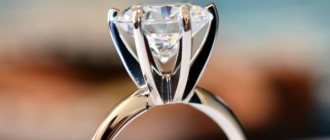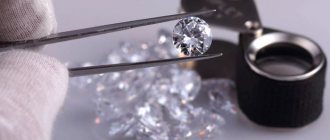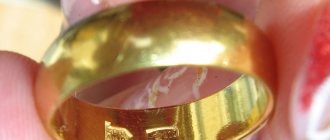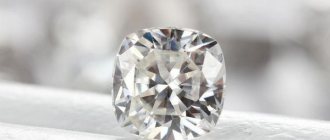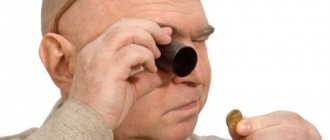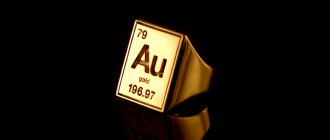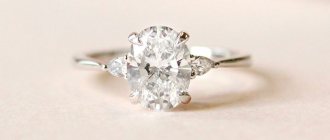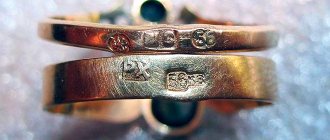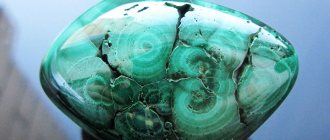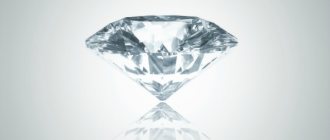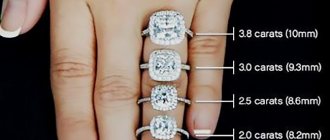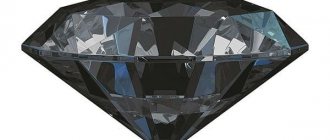There are many myths about how to distinguish a real diamond from a fake one. For example, you can put jewelry in water: the supposedly precious stone will not be visible there. Also, some believe that a real diamond will definitely leave scratches on the glass, unlike fakes. AiF.ru learned from expert gemologist of the North-Western Gemological Center for Expertise and Certification at St. Petersburg State University Anatoly Zolotarev, what analogues of diamonds exist and whether it is possible for a non-specialist to distinguish them from real precious stones.
A diamond is not a stone for you: what minerals pass off as a cut diamond?
Diamond is the strongest gem. It cannot be scratched even with great effort. It can cut glass. Any master knows what diamond coating is. But not everyone is a diamond.
Diamonds are already processed (polished and faceted) diamonds. Only 25% of diamonds are suitable for the jewelry industry.
The cutting of the stone is designed to show all its natural beauty, which is expressed in the extreme play of light. It is thanks to her that the diamond glows from the inside. The spectacle is fascinating. It's a rare person who will refuse diamond jewelry. Women dream of such a gift, men spend fabulous money... There are so many people who want it that no natural reserves would be enough.
That's why diamonds are grown artificially. To make them more accessible, cubic zirconia and some other minerals are cut into diamonds. People are happy to buy them. But there is also another side to the coin. Sometimes cheap stones are passed off as real.
cubic zirconia
Often ordinary cubic zirconias are passed off as cut diamonds. Cubic zirconia is an artificially produced mineral, crystals of zirconium dioxide. It is curious that it was not created for jewelry at all.
The first cubic zirconia was grown in the USSR about 50 years ago. It was intended for use in lasers.
But very soon jewelers noticed the stone. Cubic zirconia has a diamond luster. Its refractive index is 2.15–2.25, which is very close to gemstones. At the same time, the price for it is more than affordable.
In the 90s, cubic zirconias were often passed off as diamonds. Today it is much more difficult to deceive buyers. Their hardness is only 7.5–8.5 on the Mohs scale, while the diamond index is 10. Cubic zirconias are scratched, often have microscopic chips, and become dull from chemicals. They are heavier than diamonds. And any tester can distinguish cubic zirconia right away.
Moissanite
Moissanite is a natural mineral, silicon carbide. It is considered the most expensive diamond substitute. In terms of its optical properties, it even surpasses the original - it plays 2.5 times stronger in the light. The mineral is rare, and its size does not exceed 2 mm.
Few people know that it is not natural moissanite that is inserted into jewelry, but its synthetic analogue, carborundum.
The mineral is slightly inferior to diamond in hardness. According to the Mohs scale, its indicator is 9.25. There is another distinctive feature - birefringence. The spike visible through the platform is double. But this is not easy to consider.
Not every gemologist and tester will be able to distinguish moissanite from a real diamond. The tester must be highly sensitive, and the specialist must be experienced.
Both stones have almost the same thermal conductivity, so inexpensive testers are fooled.
Rock crystal (quartz)
Quartz is one of the most common minerals in the earth's crust. Everyone knows such varieties of quartz as amethyst, citrine, aventurine, and rock crystal. It is rock crystal that is sometimes compared to diamonds.
In ancient Greece, it was believed that rock crystal was ice turned into stone. In jewelry, its variety is valued - Marmarosh diamonds. They are very transparent, clean, well formed, and are often inserted into jewelry without cutting.
Rock crystal is similar to diamond in its transparency and purity. But any professional can easily see the difference between them.
Just look at the photo:
Next to a diamond, rock crystal looks cloudy. Its edges are smooth. If you place a stone against printed text, you will be able to distinguish the letters. In addition, when examined through a magnifying glass, clusters of small bubbles can be detected in the crystal.
Rock crystal is rarely passed off as a diamond. This way they can try to deceive only an inexperienced buyer who buys jewelry second-hand.
Glass
Beautiful rhinestones are made from glass. They differ from acrylic rhinestones by the presence of a strong shine and a high refractive index of light. Sparkling in the sun or in the spotlight on clothes, they really resemble precious stones.
The quality of glass rhinestones depends on the lead, barium or zinc content. The most famous Swarovski rhinestones contain 32% lead oxide. The effect of the play of light is simply amazing. However, glass rhinestones are easily scratched. And they are simply not inserted into jewelry.
Glass is not used in jewelry.
Famous Swarovski rings and earrings contain cubic zirconia. They are the ones most often popularly called “glass.”
What are the analogues of diamonds?
According to Anatoly Zolotarev, one of the most common diamond imitations is moissanite. Outwardly, it looks like a diamond, however, unlike a precious stone, it is not crystalline carbon, but silicon carbide. Another common imitation is cubic zirconia. This stone was synthesized at the Physical Institute of the Academy of Sciences (P. N. Lebedev Physical Institute of the Russian Academy of Sciences) in Moscow, and the name comes from its abbreviation (FIAN).
There are also natural imitations - say, the colorless mineral zircon - and synthetic diamonds created in laboratories. Unscrupulous sellers may offer so-called “treated” diamonds, that is, stones with a crack that has been “healed” with lead glass. Such stones are cheap, but a non-specialist cannot distinguish them from real ones.
Everything you wanted to know about diamonds. Infographics Read more
What does a diamond look like?
Amazing. As already mentioned, the stone fascinates with the play of light. There are 57 facets in a diamond cut, and this is no coincidence. At the beginning of the 20th century, using calculations that took into account the characteristics of the diamond, ideal cut proportions were derived to achieve maximum radiance.
We recommend: How to make a mosquito net for a window or balcony with your own hands?
What does the diamond look like in the photo:
Video:
With all of the above, “fakes” often look brighter than the “original”. Here it is appropriate to recall the expression: “Artificial stones are boring with their shine, but natural stones only sometimes delight you.”
Artificial
In terms of its composition and properties, an artificial diamond is the same as a real one. And even more perfect in some ways. The process of “growing” synthetic diamonds is simple. In laboratory conditions it is obtained in a few hours. Chemists joke: “If you press hard on coal, you get a diamond.” For production, HPHT technology is mainly used, which translates as “high pressure, high temperature”.
Synthetic stone is distinguished by the absence of inclusions. It is homogeneous and perfectly clean. It is extremely difficult to distinguish it from an equally pure real diamond. This can only be done using laboratory tests.
Real
The most significant difference between a natural diamond and an artificial one is the presence of inclusions. In nature, perfectly clean stones are extremely rare. In 99.9% of cases, the thickness contains inclusions of other materials. By the way, it is impossible to see them with the naked eye. It is necessary to examine the stone at multiple magnifications and from different angles.
Interesting to know. Inclusions in a diamond can tell experts where it is located.
What color is a diamond?
The color range of diamond is quite diverse. Basically, these are colorless minerals with a subtle yellow tint. In rare cases, gems of red, pink, brownish, gray, blue, black and even blue shades are found. Green diamonds are considered the rarest.
Color saturation greatly affects transparency. If the stone is very thickly colored and the color is distributed evenly over it, and not in spots or just the top, then such gems may not show through at all.
It receives a certain shade due to the presence of inclusions and impurities, which are responsible for the corresponding color. Various natural processes also play a huge role, namely radiation, temperature, volcanic eruptions, etc.
Professional authentication methods
Not every jeweler undertakes to check a cut diamond for authenticity. In pawn shops, diamond jewelry is valued without the stone. This is because recognizing a quality craft is very difficult. There is a high probability of making a mistake.
Gemologists are considered specialists in this field. Professional stone analysis includes:
- Inspection through a magnifying glass. First of all, the specialist looks for information at the bottom of the stone. Real jewelry has a mark. CZ is cubic zirconia, and LG and Gemesis created artificial diamonds. Under a magnifying glass they also check the clarity of the edges, the presence of defects, chips, inclusions and other things.
- Play of light. A diamond does not emit a rainbow glow. Its glow is even and silvery in color.
- Weighing on sensitive scales. At the same size, cubic zirconias are heavier than real diamonds.
- Inspection under ultraviolet light and cathode rays. It can provide information about the nature of the origin of the stone and its refining.
- Use of detectors. The devices measure thermal conductivity, electrical conductivity, and refractive index. They allow you to quickly and fairly accurately identify cubic zirconias, moissanites and other stones passed off as diamonds.
Stone jewelry
Women are not recommended to purchase diamond jewelry on their own. A diamond should be a gift from a man, only then will it fully reveal its characteristics.
Diamond settings are selected depending on the color of the crystal. White diamond is suitable for any metal - gold, silver, platinum. Black - only platinum. Reds and purples look good in white gold, while browns look good in yellow.
Diamond jewelry must be properly cared for to ensure it retains its beauty for a long time. Rules of care include:
- wear jewelry so that it does not come into contact with cosmetics and chemicals;
- You cannot wear jewelry in a bathhouse, sauna, or solarium—the heat will cause a white coating to form on the diamond;
- store diamond jewelry separately from others;
- Clean the diamond with a soft cloth moistened with soapy water.
It is recommended to have it professionally cleaned by a jeweler once a year.
Diamond jewelry is only suitable for special occasions. They are rarely worn to work or to university - during the day the shine of the diamond is lost; it best reveals its beauty in electric light or candles. For everyday wear, a modest ring or stud earrings with small crystals are suitable. Large jewelry and sets should be worn with evening dresses in a formal setting.
Even modest jewelry should be worn with formal clothing. An office suit is best. Diamond jewelry does not harmonize with jeans and T-shirts. To go out to a restaurant, you should choose a plain dress or suit, without sequins or sparkles.
View this post on Instagram
Posted by Diamonds from 585 Gold (@585_diamonds) Jun 5, 2019 at 9:00 am PDT
View this post on Instagram
Posted by Jewelry Atelier (@lance.jewels) Jun 5, 2021 at 8:03 am PDT
View this post on Instagram
Publication from ZODIAC? Jewelry salon-shop (@zoloto_zodiak_shop) November 7, 2021 at 3:39 PST
Additionally, read the article about an interesting option for placing a stone in jewelry: a dancing diamond.
To watch the video, a commentary from a famous fashion critic about diamonds, who to wear and which ones to buy:
How to distinguish a diamond from a fake at home?
Anyone can check a diamond for authenticity. To do this, you don’t always need to go to a laboratory or store.
Homemade methods will help you distinguish a natural diamond from a frankly cheap fake.
Start by inspecting the stone:
- Pay attention to the girdle. In zirconiums, the side edge is blunt, but in real diamonds it is sharp, like the blade of a sharpened knife. Run your finger along the girdle or look through a magnifying glass.
- Appreciate the sparkle. The diamond sparkles with light, gray-blue flashes. There is a feeling that it glows from within. It flashes with needles. Fake stones sparkle with a stronger surface and with all the colors of the rainbow.
- Defects. Looking at a diamond through a loupe or microscope, you will never find chips on the edges or thread-like inclusions. Small dots may be present.
- Frame. Elite stone is inserted exclusively into precious metals: platinum and gold. Particular attention is paid to the quality of fastenings. A diamond can't dangle. In addition, the distance between the paws is the same. Glue is never used to secure it.
- Price. A real diamond is always an expensive stone, even if it is not of the best quality. In 2021, the average cost of 1 carat is $8,850. The price for decoration is even higher. If the ring or earrings were purchased several times cheaper, most likely the diamonds in them are fake.
Advice. If you don't have a magnifying glass, use macro mode to photograph the jewelry. Enlarge the image on the screen and you will be able to see the stone in detail.
Water
There is a popular myth that a diamond “merges with water.” Allegedly, if you put a stone in a transparent glass of water, you can accidentally drink it. In fact, it's just a beautiful fairy tale.
The diamond is clearly visible in the water.
Firstly, its density is much higher than the density of water - 3.47-3.55 g/cm³ versus 0.10 g/cm³. Secondly, water and diamond have significant differences in the refractive index of light. However, a water test may be helpful.
In a glass of water you can see a doublet - a stone glued together from two different materials.
Vegetable oil
You can identify a diamond at home using a drop of vegetable oil. You can use any: sunflower, olive, flaxseed. The main thing is that the oil is liquid. The test is carried out as follows:
- Oil is applied to the largest edge. If the stone is real, the drop will remain intact; if it is fake, it will break up into many small droplets.
- Place the ring on its side and apply it to the glass. A drop of oil should “glue” the diamond for a few seconds. If the stone does not stick at all, it is most likely fake.
Breath
They say that if you breathe on a real diamond, it will not fog up and will remain just as shiny. This is true.
If condensation forms on a diamond, it evaporates instantly. This is the peculiarity of the surface - it does not retain moisture on itself. Other materials fog up more and retain droplets of moisture longer.
The breathing method is good. But there's one catch. If the diamond is 0.5 carats or less, then its surface is so small, then it will be extremely difficult to see the condensation.
We recommend: When to collect and how to dry currant leaves to get high-quality tea
UV light
To test a diamond for authenticity, you can use a UV pen, lighter, or flashlight. You need to turn off the light and shine it on the stone for 1 minute.
Most natural stones emit a blue or bluish glow under UV light.
In addition, they continue to glow for some time in the dark (they have luminescence). But if the stone does not glow, this is not a reason to be upset. Ultraviolet neutral diamonds are found in nature. In Europe they are even valued higher (in the USA it’s the other way around). It is believed that inertness to UV radiation is due to the absence of defects at the molecular level.
Tester
Diamond authenticity detectors are freely sold on the Internet. They come in different sensitivities. But even the simplest one can easily distinguish cubic zirconia. But to detect mussanite, you need a more expensive device. He evaluates the stone based on its electrical conductivity. Moissanite conducts electricity, but diamond does not.
The tester is brought to the stone at an angle of 90 degrees. Within a few seconds, the result is displayed on the scoreboard. The simplest Diamond Selector II can be bought on Aliexpress for 600 rubles.
Prohibited Methods
One of the most famous tests is glass cutting. A real diamond can cut it, or at least leave scratches. It scratches other stones with the same ease.
We advise you not to resort to barbaric checks. If the stone turns out to be genuine, then you will not spoil it, but you may damage the frame.
Prohibited methods include the following:
- Scratching with a diamond file.
- Glass cutting.
- Heating to high temperatures.
- Hit with a hammer.
Diamond is the hardest stone. And it is true. But at the same time it is also fragile. A blow with a hammer will destroy it.
Photos of the most beautiful diamonds in the world
Despite their impeccable beauty, diamonds of special quality have a bloody trail through centuries of history. Alas, the legends have only softened over a long time and have survived to this day in a relatively acceptable form. Of course, the 21st century has finally completed the list of terrible crimes associated with diamonds, and today stones are exhibited, sold at auctions and passed on by inheritance without the frightening crime, as was the case historically. But there are also diamonds that are crystal clear before fate and the law; we give three such examples below.
Please note that even the most famous, highest quality diamonds still have inclusions, albeit tiny ones: these defects are the direct, simple and most honest proof of the authenticity of the gemstones.
Diamond Cullinan
– its two aristocratic parts belong to the sweetest lady from Great Britain, or rather the entire English court. And the complete Cullinan family includes 9 large diamonds and about a hundred small ones. The original diamond measured 11 x 5 x 6 cm and weighed more than 600 grams (3106 carats).
| Cullinan I 530 carat | Cullinan II 317 carats |
Excelsior
– held the title of the largest diamond until the birth of Kulinan. The original weight of the Excelsior diamond was 995 carats, and after cutting, 21 beautiful diamonds were seen, and all of them quickly went to private collections and fashionable jewelry houses.
| The largest of the Excelsiors | Heidi Klum, Excelsior advertising | Diamond before cutting |
Centenary
- closes the top three and at the same time is the most mysterious, albeit infinitely beautiful diamond in the world. 274 carats were cut by professionals from De Beers, and the stone owes its origin to the same mine in South Africa where Cullinan was found. Today Centenary is not exhibited and, moreover, it is unknown where this marvelous diamond, insured for a record amount of $100 million, is located.
The cost of such diamonds is incalculable, and it is unlikely that at least one of them will ever be sold again. The price of 2.5 million dollars for one of these stones is very modest, and a diamond presented by Heidi Klum as a swimsuit decoration was sold for $11 million.
In our store, diamonds are presented, of course, not in such a stellar format, but the authenticity and quality of the stones indicated in the characteristics certainly does not raise doubts or questions.
The catalog of diamond products includes various jewelry and accessories; we are sure that here you can find a gift for yourself or a loved one. All diamond products come with an expert opinion, and when purchasing online there is an additional 5% discount.
Authentication check in a laboratory or specialist
You can find out with a 100% guarantee whether a diamond is genuine or fake, only by submitting the stone for examination to a gemological laboratory.
There are such laboratories in all major cities. The most famous in Russia is the Gemological Center of Moscow State University. On average, the examination costs 1,200 rubles. Duration: from 1 hour to 2 days. A written expert opinion and a legal document (certificate) costs a little more - 1500-3000 rubles. Here you can evaluate the stone and find out its real value.
For identification, laboratories use special equipment:
- gemological triplet magnifying glass;
- visible spectrometers with near-UV and IR capabilities;
- Raman spectrometers for analyzing the composition of inclusions, various structural features and impurity centers;
- other.
Even HPHT treated diamonds can be identified in laboratories. They have characteristic crystal lattice defects. When determining the authenticity of a stone, a specialist gives a full conclusion, including checking its quality characteristics.
What affects the price of a diamond?
Diamond is different from diamond. Even “originals” of the same size can differ in price by more than 60%. The most valuable are considered to be untreated, large stones with ideal purity, hardness, color, transparency and cut.
Most gemological laboratories around the world rely on the GIA classification called the “4Cs” to determine the value of diamonds. It was developed in 1953 at the Gemological Institute of America. The higher the 4C score, the more expensive the stone is considered.
The four main characteristics that determine the quality and cost of diamonds are carat, cut, color, clarity.
- Weight (Carat). 1 carat is equal to 0.2 g. Diamonds larger than 1 carat are considered large. The average weight is 0.3-0.99 carats. Stones smaller than 0.29 carats are considered small.
- Color. The most expensive diamonds are considered to be completely colorless diamonds, which are rare in nature. They belong to group D. There are also stones of a pale yellow hue, fancy colors.
- Clarity. The main evaluation criterion. The fewer inclusions in a stone, the more transparent it is, the higher its cost.
- Quality of cut (Cut). Thanks to skillful cutting, a diamond becomes a diamond. In the expensive version, precise geometry, proportions, and correct angles are observed.
Criteria that will help you roughly evaluate a diamond and determine its quality:
- Table No. 1:
- Table No. 2:
Properties and uses of diamonds
In terms of physical properties, diamonds are identical to diamonds. In terms of beauty, a diamond is significantly superior to a natural diamond crystal. Processed stones are used only for decorative purposes - making jewelry and souvenirs.
Some people attribute magical and healing properties to diamonds. Therefore, the jewel is used for healing and performing magical rituals.
Physical properties
A diamond, like a diamond, is made up of carbon atoms. The chemical formula is C. The atoms are arranged in a strict order, forming cubes.
Diamond density is 3.47-4.55 grams per cubic centimeter. The hardness is 10 on the Mohs scale - it is the hardest substance. At the same time, it is quite fragile and can be broken by hitting it hard with a heavy object.
The diamond has absolute transparency. The refractive index is 2.4.
The melting point under normal conditions is 4000 degrees. In a vacuum, a diamond burns at 700-900 degrees.
Medicinal properties
Diamond is actively used in lithotherapy. This is a branch of medicine that uses stones for treatment. Lithotherapists believe that the jewel has the following healing properties:
- reduction of headaches;
- increased mood;
- improving sleep quality, eliminating insomnia and nightmares;
- strengthening the heart muscle, normalizing blood pressure;
- improving the condition of skin, hair and nails.
To reveal the healing properties, experts recommend wearing the stone on your left hand or in the heart area. It is beneficial to drink the water in which the diamond was lying.
Magic properties
Diamond is the king of all precious stones. Therefore, it must belong to a strong and powerful person. The magical properties of diamonds have been known for a long time.
Sorcerers and mediums endow a diamond with the following qualities:
- the stone brings good luck to warriors and protects them from death in battle;
- enhances human energy, not only positive, but also negative;
- strengthens the health of the owner;
- improves communication skills;
- adds charm to the owner.
Diamond is a symbol of love. The custom of giving a girl a diamond ring as a sign of engagement is based on the stone’s ability to protect the owner from evil intentions towards him.
The magical properties of diamonds are most evident if the owner has pure and good thoughts. If a person is planning evil, his plans will be upset and turn against him.
Who is the stone suitable for according to their zodiac sign and name?
In astrology, diamond is associated with the Sun. Therefore, the stone is suitable for all zodiac signs, but some nuances should be taken into account.
Table of compatibility of the stone with the signs of the Zodiac.
| Sign | Peculiarities |
| Aries, Sagittarius, Leo | They perceive the energy of the stone better than other signs and use it for their own purposes. |
| Libra, Aquarius | Jewelry helps these signs cope with shortcomings and gain self-confidence |
| Capricorn | For Capricorn, a white or blue diamond is suitable, which will help achieve their desired goals |
| Cancer, Pisces | Will help organize thoughts and give vital activity |
| Taurus | Taurus needs a black diamond, it will give self-confidence |
| Twins | Green diamond will improve health and help you gain wealth |
| Virgo, Scorpio | A stone of any color except black will bring good luck in life. |
The diamond is suitable for owners of strong names - Alexander, Victor, Konstantin, Anna, Maria, Margarita. For such people, the jewel will bring success in their career and personal life.
What can it be easily confused with?
A diamond in a piece can be replaced not only at the jewelry manufacturing stage, but also in a jewelry salon. Counterfeits have been used for a long time; they existed back in 1920. In the past, they tried to pass off radiant or corundite as a diamond. Later, other cheap imitators of the “royal stone” appeared - strontium, rutile, titanium, white sapphire.
Modern technologies have made it possible to create artificial stones that are absolutely identical in appearance to processed diamonds. They are made of such high quality that even testers are not always able to recognize a glass diamond.
The properties of a gemstone are best imitated by the following fakes:
- Cubic zirconia (zircon) is a synthetic stone, zirconium dioxide. It was invented by Soviet physicists in the 70s of the last century. Since then, products with cubic zirconia have been sold all over the world. Zircon shines almost as brightly as a diamond, but with iridescent highlights. It can be transparent (the most expensive) and colored. Currently, cubic zirconia is produced in six main colors.
- Moissanite is carborundum, the most accurate artificial copy of a diamond. It is 90% similar to the precious “prototype”. Its shine is even more intense than that of the “king of stones”. It is impossible to identify moissanite by eye; even an experienced jeweler can make a mistake. Not all testers are up to this task.
- Rock crystal is similar in appearance to a diamond, and after cutting it acquires a dazzling shine. You can recognize an imitation by the following characteristics: rock crystal is set in silver, less often - in gold, a diamond is set only in platinum and gold. Glue is often used to fix crystal, but this is not done when working with diamonds.
The following are also sold under the guise of a processed diamond:
- white topaz;
- yttrium aluminum garnet;
- leucosapphire;
- white beryl;
- artificial diamond;
- transparent spinel;
- rhinestones (ornamental stones made of glass);
- combinations of synthesized stones.
TEST YOUR DIAMOND AT HOME WITH REFRACTION
When you see a sparkling diamond, you are observing its ability to bend and refract light. When light hits the pavilions (the angled surfaces on the bottom half of the diamond), it is reflected and refracted upward through the diamond's table (the top flat surface) to the naked eye. When a diamond does this job well and shines, it is called brilliance.
Non-diamond stones such as cubic zirconia will also not refract light. They will have less shine, if any at all.
IS THE SCRATCH TEST RELIABLE TO MAKE SURE A DIAMOND IS REAL?
Scratching was once a widely used method to determine the mineral hardness of a gemstone. The test involved running a gemstone across a mirror to see if it would scratch the mirror or the stone.
Although diamond is formed from very durable materials, fakes such as cubic zirconia and moissanite are quite durable and scratch resistant. For these reasons, the scratch test is not accurate. You're better off using other tests, such as a thermal conductivity test or examining the diamond with a professional loupe.
CHECK YOUR DIAMOND AT HOME WITH REFLECTION
In addition to refraction, you can test a stone by its reflectivity. While refraction refers to the directions in which light is reflected, reflectance refers to the quantity and quality of light that is reflected from the stone.
Reflectivity includes both brilliance (the sparkle of white light) and fire (colored light) emanating from the table of the diamond.
To check reflectivity, use the radiance test.
 Glow test
Glow test
The radiance test requires no equipment other than your eyes. Hold the diamond under a regular lamp. See how the light reflects off the stone. Do you see bright shimmers of white light reflecting off the diamond? Do you also see multi-colored reflections of light?
A real diamond reflects white light very well, producing exceptional brilliance. Diamonds are also excellent at reflecting colored light or fire.
If you compare a real diamond to a fake diamond such as cubic zirconia, you will be able to notice a dramatic difference in the white and colored glow of light that comes from the real diamond.
CHECKING A REAL DIAMOND VS. MOUISSANITE
With the increasing presence of synthetic moissanite on the market, it is important to use a jeweler's tools to verify authenticity. These tools can tell whether a diamond is real or fake almost immediately.
13) Examination using a microscope
With 1200x magnification, a jeweler or gemologist can examine the stone in detail on a powerful microscope. At this level of magnification, they will be able to see inclusions and slight differences in real diamonds compared to moissanite.
14) Perform an X-ray examination
To test a stone's internal molecular qualities, have it tested by a professional diamond laboratory. Their X-ray machines will be able to determine whether the stone has a radiopaque molecular structure. Diamonds are radiolucent, while fakes such as cubic zirconia and crystals are more radiopaque.
Buying Tips
Finally, a few recommendations that will definitely not be superfluous:
- A diamond is the most expensive stone on the planet; the cost of 1 carat of the best jewelry purity for 2021 in Russia tends to one million rubles. Too low a price should alert you.
- In some cases, moissanite can be determined by a simple temperature test - heat the pebble to +70 degrees Celsius. The carbide compound will certainly turn green and retain a specific shade even after complete cooling.
- A drop of ordinary sunflower oil on a genuine diamond remains an even pea, but on any of the imitations it spreads in different directions.
- An extreme testing option is to drop sulfuric or hydrochloric acid onto the surface of the stone. Most synthetic fakes will inevitably corrode.
- Contrasting temperatures will help identify glass. A sharp drop will certainly affect the counterfeit - it will become covered with a fine web of cracks or even crumble.
- It is extremely difficult to distinguish colorless topaz from diamond using most tests, since both stones have approximately the same hardness on the Mohs scale. Here only spectrometer data and painstaking laboratory examination will come to the rescue.
In unpleasant situations, when the slightest doubt arises about the authenticity of the products, do not hesitate to demand regulatory documents from the seller. If we are talking about expensive jewelry inlaid with a stone weighing more than 1 carat, then by default it is accompanied by a GIA certificate, or its Russian equivalent - MGC at Moscow University.
